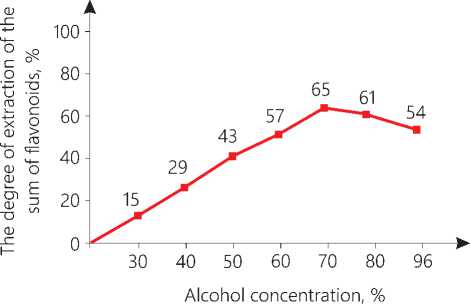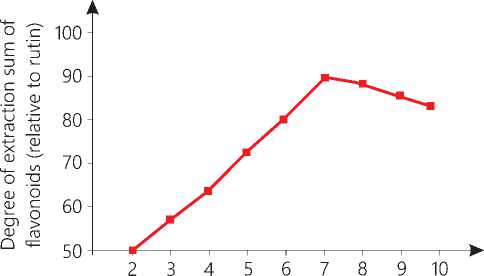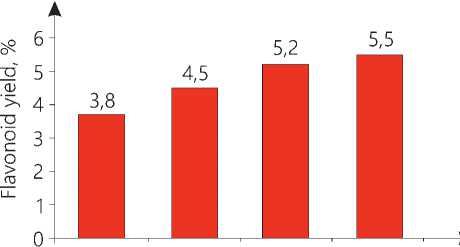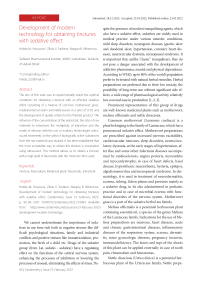Development of modern technology for obtaining tinctures with sedative effect
Автор: Yunusova H.M., Turdieva Z.V., Ilkhamova N.B.
Журнал: Cardiometry @cardiometry
Рубрика: Report
Статья в выпуске: 21, 2022 года.
Бесплатный доступ
The aim of this work was to experimentally select the optimal conditions for obtaining a tincture with an effective sedative effect consisting of a mixture of common motherwort grass, medicinal lemon balm and nettle leaves in a ratio of (1:1:1) and the development of quality criteria for the finished product. The influence of the concentration of the extractant, the ratio of raw materials to extractant, the multiplicity of extraction and the mode of infusion with the use of auxiliary technologies (ultrasound treatment) on the yield of biologically active substances from the raw materials was studied. It has been established that the most acceptable way to obtain this tincture is maceration using ultrasound. This method allows us to obtain a tincture with a high yield of flavonoids with the minimum time used.
Tincture, maceration, medicinal plant, flavonoids, extractant
Короткий адрес: https://sciup.org/148323983
IDR: 148323983
Текст научной статьи Development of modern technology for obtaining tinctures with sedative effect
Imprint
Holida M. Yunusova, Zilola V. Turdieva, Nargiza B. Ilkhamova. Development of modern technology for obtaining tinctures with sedative effect. Cardiometry; Issue 21; February 2022; p. 90-94; DOI: 10.18137/cardiometry.2022.21.9094; Available from: development-modern-technology
We cannot underestimate the importance of sedatives in our time rich both in negative stresses like difficult psychological situations, family and industrial conflicts and positive stresses like immatriculation, promotion, the birth of a child etc. Drugs of the sedative group (from Lat. sedatio - sedation) have a regulating effect on the functions of the central nervous system, enhancing the processes of inhibition or lowering the processes of arousal, eliminating the effects of stress. De- 90 | Cardiometry | Issue 21. February 2022
spite the presence of modern tranquilizing agents, which also have a sedative effect, sedatives are widely used in medical practice under various neurotic conditions, mild sleep disorders, neurogenic diseases (gastric ulcer and duodenal ulcer, hypertension, coronary heart disease), neurocircular dystonia, menopausal syndrome. It is important that, unlike “classic” tranquilizers, they do not pose a danger associated with the development of addictive phenomena, mental and physical dependence. According to WHO, up to 80% of the world’s population prefer to be treated with natural herbal remedies. Herbal preparations are preferred due to their low toxicity, the possibility of long-term use without significant side effects, a wide range of pharmacological activity, relatively low cost and ease in production [1, 2, 3].
Prominent representatives of this group of drugs are well-known medicinal plants such as motherwort, melissa officinalis and nettle dioecious.
Common motherwort (Leonorus cardiaca) is a plant belonging to the family of Lamiaceae, which has a pronounced sedative effect. Motherwort preparations are prescribed against increased nervous excitability, cardiovascular neuroses, sleep disorders, neurocircu-latory dystonia, at the early stages of hypertension, after flue and some other infectious diseases accompanied by cardiosclerosis, angina pectoris, myocarditis and myocardystrophy, in case of heart defects, basal disease, hypersthenic neurasthenia, hysteria, epilepsy, algodismenorrhea and menopausal syndrome. In dermatology, it is used in treatment of neurodermatitis, eczema, itching, lichen planus and psoriasis mainly as a sedative drug, in its also administered in pediatric practice and in case of microbial eczema with functional disorders of the nervous system. Motherwort grass is a part of the sedative herbal tea blends.
Melissa officinalis is a perennial herbaceous plant containing essential oil, a species of the genus Melissa of the Lamiaceae family. Indications for the use of Melissa preparations are neuroses, heart diseases, acute and chronic gastrointestinal diseases, inflammatory diseases of the respiratory system, eczema, dermatitis, some gynecologic diseases, pregnancy toxicosis, immunodeficiency. The leaves and tops of the shoots of this plant can be applied externally in case of tooth pain, rheumatism and hematomas.
Nettle dioecious (Urtica dioica) is a perennial herbaceous plant of the Urticaceae family. Nettle prepa- rations are used to solve some problems with copious menstrual bleeding disorders, in case of non-copious bleeding in the post-coagulation period of treatment of cervical erosion, in case of menopausal bleeding, subserous fibromyomas, in case of some abnormal postpartum events like involution of the uterus. Decoction from the leaves is taken in treatment of diseases of the liver, the biliary tract and in case of helminthic invasion. In dental practice it can be administered to treat periodontitis and gingivostomatitis [4, 5].
The aim of our study is to develop a method for obtaining a tincture with a sedative effect, conventionally called “Biosedation”, consisting of a mixture of common motherwort grass, medicinal lemon balm and nettle leaves in a ratio (1:1:1).
For the study, grass and leaves of plants collected in the period May-July in the territory of the Tashkent region were used. Drying of plant material in one layer was carried out in the natural way at a room temperature in a ventilated room with periodic turning over of the materials. As a result from using the method of natural drying, intact dried leaves of the plant were obtained.
The next step was to select the optimal extractant. Our experiment was carried out with three samples selected on the basis of the available reference literature data. We selected ethyl alcohol solutions of various concentrations as samples. Extraction was carried out from the weights of the same sample of raw materials, under the same conditions (at a room temperature, for 3 hours); the ratio of raw materials to extractant was 1:10. The produced tinctures were clear liquids, light brown in color, with a characteristic aromatic odor. The yield of flavonoids from plant raw materials was determined by spectrophotometry. As a result of the experiment, 70% ethyl alcohol was chosen as the optimal extractant, since the maximum yield of flavonoids was extracted by this particular extractant (see Figure 1 herein).

Figure 1. Dependence of the completeness of flavonoid extraction on the concentration of ethyl alcohol
Quantitative assessment of the number of flavonoids. Our assessment was carried out by the spectrophotometric method. 2.0 ml of the drug was placed in a measuring flask with a capacity of 25 ml, then 5 ml of a 2% alcohol solution of aluminum chloride was added, placed for 3 minutes in a boiling water bath, quickly cooled and made up with the 70% alcohol solution to reach the required measuring mark.
The optical density of the obtained solution was measured with a spectrophotometer at a wavelength of 409 nm in a cuvette with a layer thickness of 10 mm, using a solution consisting of 2.5 ml of medicine as the reference solution, which was placed in a measuring flask with a capacity of 25 ml with adjusting the volume with the 70% alcohol solution to the required measuring mark.
The optical density of a solution containing 1 ml of a solution of SOVS rutin treated analogically to the test solution was measured in parallel, placed in a measuring flask with a capacity of 25 ml with adjusting the volume with the 70% alcohol solution to the required measuring mark, using a solution consisting of 1 ml of a solution of SOVS rutin as the reference, which was placed in a measuring flask with a capacity of 25 ml and the volume of the solution adjusted with 70% alcohol to the designed mark.
The content of the number of flavonoids in the preparation (X, g / ml), in terms of rutin, was calculated by the formula:
D i x 25 x a о x P X ,
D 0 x 25 x 100 x 2,5 x 100
where: D 1 is the optical density of the test solution;
D 0 is the optical density of the SOVS rutin solution;
P is the content of routine in the SOVS, in %;
a 0 is the weight of the suspension of the SOVS rutin, in g.
The number of flavonoids in the preparation, in terms of rutin, should be at least 0.0003g / ml.
Note: Preparation of the solution is rutin.
About 0.05 g of rutin (USP, BP, Eur. Ph., CP, “Sigma” catalog number 125143 or similar quality) (exact weight) pre-dried at 130-135 ° C for 3 hours, dissolved in 50 ml of 70% ethyl alcohol in a 100 ml volumetric flask, was heated in a boiling water bath, cooled to a room temperature, the volume of the solution alcohol is made up to reach the required measuring mark and stirred. The shelf life of the solution is 1 month.
Preparation of 2% alcohol solution of aluminum chloride
2 g of aluminum chloride was dissolved in 50 ml of 70% alcohol in a measuring flask with a capacity of 100 ml, the volume of the solution is brought to reach the required measuring mark with alcohol and mixed [6, 7, 8].
Investigation of extraction dynamics . When extracting plant raw materials, in order to prevent unreasonable costs, it is necessary to study the required duration of the extraction process. Therefore, in order to determine it and establish the time of the phase equilibrium, we have studied the dynamics of the extraction process. There is data available in the reference literature on the study of the dynamics of the process with various extraction methods. However, first of all it depends on the type of raw materials used [5].
Experiments to determine the time of the phase equilibrium were carried out according to the methodology described in our paper. The study of the extraction dynamics has shown that the concentration of flavonoids in the tincture gradually increases and reaches a maximum by 6 days (see Figure 2 herein).

Time
Figure 2. Effect produced by extraction time on flavonoid yield
The effect made by the degree of grinding of raw materials on the yield of flavonoids from medicinal plant raw materials. Of particular importance for the extraction of active substances from plant material is the degree of its grinding. It is known that the greater the fineness, the more complete the diffusion proceeds, which is due to an increase in the contact surface of the phases. To a large extent, the completeness of the extraction of the target substance depends on the degree of grinding of plant raw materials.
When searching for the optimal value of the degree of grinding, we used raw materials which were crushed to various degrees: larger than 10 mm, 3–10 mm, 1–3 mm, and smaller than 1 mm. As expected (see Figure 3 herein), with finer grinding
92 | Cardiometry | Issue 21. February 2022
of raw materials, the yield of flavonoids increased. The grinding of raw materials contributes to an increase in the surface area of the phase interface, but at the same time the inadmissibility of slurping with excessively fine grinding should be taken into account. Thus, the yield of active substances when using raw materials with a size greater than 10 mm is 3.8%, when grinding 3–10 mm, reaches 4.5 %, at 1–3 mm we obtain 5.2%, and under 1 mm we can obtain even 5.5%. However, taking into account that the excessively fine grinding of raw materials significantly complicates the filtration of the resulting tincture, and, moreover, the yield of flavonoids from raw materials crushed less than 1 mm varies slightly, we have decided that the grinding degree of 1–3 mm is the best suitable for our purpose.

more 10 mm 3-10 mm 1-3 mm less 1 mm
Degree of grinding
Figure 3. Results of studying the degree of grinding of raw materials
Selection of the ratio of raw materials to extractant . At the next stage of the study, the optimal ratio of raw materials to extractant was determined to increase the yield of extracted substances. As can be seen from Table 1, the yield of active substances from raw materials is the highest at a ratio of 1:10.
Table 1
Dependence of the completeness of flavonoid extraction on the ratio of raw materials and extractant
|
The ratio of raw materials and extractant |
The degree of extraction of the number of flavonoids, % |
|
1:5 |
48,1-54,9 |
|
1:10 |
87,7-91,2 |
|
1:20 |
65,5-79,8 |
Selection of the extraction method. The following extraction methods were considered as possible methods for obtaining alcohol extraction from raw materials: maceration, bismaceration, maceration+UST (ultrasound treatment), bismaceration+UST and remaceration +UST.
The maceration method is a recognized extraction method, which is very widely used in the pharmaceutical industry. This method does not require complex equipment; it is a simple technology showing a good yield of a biologically active complex of extractive substances. However, as our analysis of the reference literature shows, this method is losing its popularity due to a number of its disadvantages such as high time- and labor- intensity; possible evaporation of the extractant, an incomplete extraction of BAS, lower yields compared to other extraction methods. In this regard, alternative extraction methods are being developed: remacery, turbo extraction, ultrasonic and microwave extraction, percolation, extraction with liquefied gases and others.
The method of ultrasonic extraction is considered by many authors as a method of intensification in the technology of producing extracts. The spectrum of waves involved in ultrasound is called ultrasonic waves, and the frequencies of these waves are above the sound range (> 20 kHz) and below the microwave frequencies (up to 10 MHz). The process can be organized by direct exposure of ultrasound to the sample using a probe or indirectly in an ultrasound bath through the walls of a vessel containing a sample to be treated. Ultrasonic exposure is based on the principle of acoustic cavitation, which destroys cellular structures. With the increase in ultrasonic power, the number of cavitation bubbles increases, the collapse of which leads to some local temperature and pressure jumps. This process facilitates the disintegration of plant cells [9, 10].
When analyzing the effect produced by ultrasound on the extraction of flavonoids from a mixture of parts of medicinal plants of motherwort, melissa and nettle, it was found that their higher yield is achieved faster than traditional extraction, and the extraction process was reduced due to the intensification of the ultrasound process. To obtain the tincture by maceration using ultrasound, one part of the raw material was poured with ten parts of the extractant, taking into account the alcohol absorption coefficient, and ultrasound treatment was carried out for 40 minutes. The extract pre-product was drained, pressed and kept at 2-8 ° C during the day. Then it was filtered through a paper filter. It should be noted that when using ultrasound, the extract turns cloudy due to a large number of suspended particles of raw materials, but it is quite easily cleaned during filtration. Thus, the rec- ommended tincture with a sedative effect should be obtained by maceration using ultrasound.
Table 2
Quality indicators of the recommended tincture “Biosedation” obtained under different infusion modes (n=3)
|
Infusion mode |
Description |
Dry residue, % |
Flavonoid content (in terms of rutin), g/ml |
Ethanol con-tent,% |
|
Maceration |
Transparent liquid, light brown in color, with a characteristic aromatic odor |
1,7 |
0,0028±0,03 |
64 |
|
Bismaceration |
1,5 |
0,0028±0,03 |
63 |
|
|
Macera-tion+UST |
1,9 |
0,0003±0,03 |
89 |
|
|
Bismacera-tion+UST |
1,4 |
0,0028±0,01 |
75 |
|
|
Remacera-tion+UST |
1,4 |
0,0028±0,03 |
68 |
Conclusions
When developing a method for obtaining a tincture with a sedative effect, consisting of a mixture of common motherwort grass, medicinal melissa and nettle leaves, the most optimal extraction method, considering the quantitative content of flavonoids in terms of rutin, is maceration using ultrasound treatment, and the most optimal extractant in this case is 70% ethyl alcohol. According to the obtained results of the influence of the degree of grinding of raw materials on the yield of flavonoids from medicinal plant raw materials, our decision is to utilize grinding degree of 1-3 mm, and the ratio of raw materials to extractant shall be 1:10.
Statement on ethical issues
Research involving people and/or animals is in full compliance with current national and international ethical standards.
Conflict of interest
None declared.
Author contributions
The authors read the ICMJE criteria for authorship and approved the final manuscript.
Список литературы Development of modern technology for obtaining tinctures with sedative effect
- Sharipova ST, Yunusova HM, Komilov HM, Hamdamov M.M., Mullazhonova M.T. Development of a spectrophotometric method for quantitative determination of active substances in dry extract "Meliflos". Pharmaceutical Bulletin of Uzbekistan. 2011;3:77-9.
- Sharipova ST, Rakhimova OR, Kuldoshev A. Development of an anti-inflammatory extract from leaves and immature fruits of walnuts. International Journal of Pharmaceutical Research. April-June 2020;12(2):729-36.
- Ilkhamova NB, Jalilov HK, Yunusova HM. Creation of a drug from plant raw materials against cough based on the teachings of Abu Ali Ibn Sino. The value of education inherited from Abu Ali Ibn Sino education hurrah. Bukhara. 2017. p.104-105.
- Ilkhamova NB, Nazarova ZA, Yunusova KhM. Studying the effect of а relative humidity and compaction pressure on the quality of tablets and pressed mass. World Journal оf Pharmacy аnd Pharmaceutical Sciences. 2019;8(6):35-40.
- Sherkhadjayeva NN, Yunusova KhM, Ilkhamova NB. On the of choosing the composition of soluble tablets with licorice extract. World Journal оf Pharmacy аnd Pharmaceutical Sciences. 2019;8(6):41-7.
- Ravshanova SE, Yunusova KhM. Evaluation of biopharmaceutical and pharmacological properties of combined ternary componential analgesic tablets. International Journal of Psychosocial Rehabilitation. United Kingdom. 2020;24(2):6009-17.
- Yunusova KhM, Jaloliddinova MSh. Studying pharmacotechnological aspects and stability of "Ortof-S" tablets. World Journal of Pharmacy and Pharmaceutical Sciences.2019;8(1):277-88.
- Abdijalilova ZKh, Yunusova KhM. Study of influence of technological factors on indicators of quality of tablets of secrolitic action. World Journal of Pharmacy and Pharmaceutical Sciences. 2020;9(1):373-80.
- Abdijalilova ZK., Yunusova KhM, Ilkhamova NB. Pre-clinical study of expectorant properties of "Ambrol" tablets. International Journal of Psychosocial Rehabilitation. 2020;24(4):2349-54.
- EDN: NQQDNR
- Yunusova KhM, Jaloliddinova MSh. Biopharmaceutical aspects of capsulirine drug based on NSAIDs. International Journal of Psychosocial Rehabilitation. 2020;24(4):2258-65.
- EDN: UXUMCV


